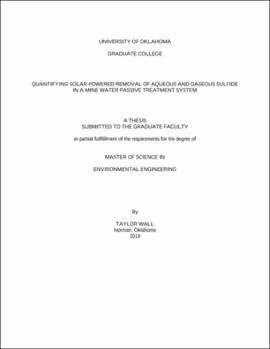| dc.description.abstract | Passive treatment systems can improve water quality for mine water discharges. However, some process units, like vertical flow bioreactors (VFBRs), may produce excess sulfide, which can be a source of nuisance odors and toxicity. Aqueous sulfide concentrations greater than 0.002 mg/L are considered chronically toxic to aquatic life, and prolonged human exposure to gaseous concentrations greater than 20 ppmv may lead to fatigue, poor memory and dizziness. In this study, a novel sulfide removal approach using a custom-designed solar-driven system and activated carbon filter (ACF) was evaluated. The study site, the Southeast Commerce passive treatment system (SECPTS) at the Tar Creek Superfund Site in Oklahoma, addresses 380 L/min of net alkaline lead-zinc mine waters in a four process unit passive treatment system. VFBR effluent enters a closed odor control structure (OCS) from which the sulfide-rich atmosphere is pulled into the ACF using a solar-powered exhaust blower. The ACF includes 180 kg of GC Sulfursorb activated carbon media. Aqueous sulfide concentrations were determined by laboratory analyses of surface grab water samples and gaseous sulfide concentrations were measured using a handheld gas detector and Draeger hydrogen sulfide gas detection tubes. Throughout the sampling period (December 2017-October 2018) maximum aqueous sulfide concentrations in the VFBR effluent were 83,750 µg/L, and gaseous sulfide concentrations in the OCS atmosphere were 950 ppmv, although values were typically lower. In addition to the sulfide removal system, solar-powered blowers re-aerate the water column in the post-VFBR final polishing unit (FPU). FPU effluent aqueous sulfide concentrations measured 131 279 g/L. ACF exhaust gaseous sulfide concentrations measured 41 56 ppmv. Over the study period, approximately 14,000 kg S were retained by SECPTS, presumably mainly via bacterial sulfate reduction in the VFBR. Additionally, 100 kg gaseous S entered the ACF with 30 kg retained in the ACF media, 20 kg leaving the ACF as exhaust to the open atmosphere and 40 kg leaving the ACF in liquid form as sulfuric acid. Evaluation of the off-the-grid renewable energy-powered sulfide-removal and aeration systems indicates that they enhance water quality improvement effectiveness, efficiently remove gaseous sulfide and may be especially attractive for use in remote locations and/or at sites where operation and maintenance budgets are limited. | en_US |
